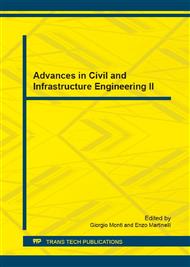p.222
p.233
p.240
p.248
p.257
p.266
p.273
p.281
p.290
An Innovative Dual System for New Structures or for the Retrofit of Precast Concrete Industrial Buildings
Abstract:
In this work, the possibility to improve the seismic behaviour of precast concrete buildings is examined by proposing the adoption of a dual system composed by the internal pendular columns of the building and the external cladding walls. To this scope, it is suggested to substitute the joints classically adopted at the top of the panels with a connection able to work as a slider with vertical axis and to insert at the bottom of the walls two or more hysteretic dampers working on the uplift of the cladding panels occurring under seismic actions. With this approach, with respect to the classical design philosophy, due to the participation of the cladding panels, the structure is stiffened, obtaining a reduction of the lateral drifts under serviceability limit states, and its seismic behavior is improved due to the additional source of energy dissipation represented by the dampers located at the base of the walls. The effectiveness of the suggested approach is verified on a case study designed following the proposed approach.
Info:
Periodical:
Pages:
257-265
Citation:
Online since:
July 2016
Keywords:
Price:
Сopyright:
© 2016 Trans Tech Publications Ltd. All Rights Reserved
Share:
Citation:


